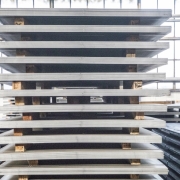An Overview of ASTM A553 Type I (9% Ni) Steel Plate
Introduction
ASTM A553 Type I is a specialized steel plate incorporating 9% nickel explicitly designed for cryogenic applications. This steel is known for its remarkable toughness and strength at very low temperatures, making it an essential material in industries where extreme cold is a factor. The unique properties of ASTM A553 Type I (9% Ni) steel plate make it a critical choice for constructing storage tanks, pressure vessels, and other structures that need to withstand the challenges of cryogenic environments.
Chemical Composition
The chemical composition of ASTM A553 Type I (9% Ni) steel plate is meticulously engineered to deliver its desired properties. The 9% nickel content is the key ingredient that enhances the steel’s toughness at low temperatures. Here is the typical chemical composition:
Carbon (C): ≤ 0.13%
Manganese (Mn): ≤ 0.90% (heat analysis), ≤ 0.98% (product analysis)
Phosphorus (P): ≤ 0.015%
Sulfur (S): ≤ 0.015%
Silicon (Si): 0.15–0.40% (heat analysis), 0.13–0.45% (product analysis)
Nickel (Ni): 8.50–9.50% (heat analysis), 8.40–9.60% (product analysis)
Other Elements: Small amounts of molybdenum and niobium (columbium) may also be present in varying amounts.
The controlled carbon levels and nickel addition are significant, as they contribute to the material’s exceptional low-temperature properties.
Mechanical Properties
ASTM A553 Type I (9% Ni) steel plate is designed to offer outstanding mechanical properties, especially in environments where temperatures drop to cryogenic levels. The vital mechanical properties include:
Tensile Strength: 690–825 MPa (100–120 ksi)
Yield Strength: ≥ 585 MPa (85 ksi)
Elongation: ≥ 18% (in a 200 mm gauge length)
Impact Toughness: High toughness, tested at temperatures as low as -196°C (-321°F)
These properties are achieved through carefully controlled composition, heat treatment, and manufacturing processes. The steel’s high yield and tensile strength ensure it can handle significant stresses without deformation or failure. At the same time, its impact toughness is critical for resisting brittle fracture in cryogenic conditions.
Applications
ASTM A553 Type I (9% Ni) steel plate is specifically designed for use in environments where materials are exposed to extremely low temperatures. Some of the critical applications include:
LNG Storage Tanks: Liquefied Natural Gas (LNG) storage tanks are one of the primary applications of ASTM A553 Type I steel plates. LNG is stored at temperatures around -162°C (-260°F), requiring materials that maintain structural integrity under these conditions.
Cryogenic Vessels: Cryogenic vessels used for storing and transporting gases like nitrogen, oxygen, and hydrogen in liquid form often rely on ASTM A553 Type I steel because it can withstand low temperatures without becoming brittle.
Petrochemical Industry: This steel is frequently used in the petrochemical industry for storage tanks and piping systems for cryogenic fluids. Its resistance to brittle fracture ensures safety and reliability in these critical applications.
Aerospace: Certain components in the aerospace industry, where materials are exposed to extremely low temperatures during flight or in outer space, may use ASTM A553 Type I steel for its dependable performance.
Other Low-Temperature Applications: The properties of ASTM A553 Type I steel plates can benefit any application that requires reliable performance at low temperatures, such as certain military and research equipment.
Advantages of ASTM A553 Type I (9% Ni) Steel Plate
Superior Toughness at Low Temperatures: The addition of 9% nickel significantly improves the toughness of the steel at cryogenic temperatures, making it highly resistant to brittle fractures.
High Strength: The steel plate’s high tensile and yield strengths allow it to withstand high pressures, making it ideal for pressure vessels and other high-stress applications.
Durability and Longevity: ASTM A553 Type I steel plates are known for their durability, ensuring a long service life even in the most demanding environments.
Versatility: While it is primarily used in cryogenic applications, this steel plate’s properties make it suitable for various low-temperature applications across multiple industries.
Fabrication and Welding
ASTM A553 Type I steel plates can be fabricated and welded using standard industrial processes, although certain precautions are necessary due to the material’s high nickel content. The steel is typically delivered in a quenched and tempered condition, which enhances its mechanical properties.
Welding Considerations:
Preheat and Interpass Temperatures: Careful control of preheat and interpass temperatures is required to avoid thermal stresses that could affect the steel’s low-temperature properties.
Post-Weld Heat Treatment (PWHT): In some cases, PWHT may be required to relieve residual stresses and restore toughness.
Forming:
The steel’s high strength requires careful consideration during forming processes to avoid cracking or other issues. Cold forming is possible, but the high nickel content requires careful control of the forming process.
Standards and Specifications
ASTM A553 Type I (9% Ni) steel plate conforms to international standards, making it a globally recognized material for cryogenic applications. These standards ensure consistent quality and performance, regardless of where the steel is produced or used.
Some of the relevant standards include:
ASTM A553: Standard Specification for Pressure Vessel Plates, Alloy Steel, Quenched and Tempered 8% and 9% Nickel.
ASME Boiler and Pressure Vessel Code (BPVC) Recognizes ASTM A553 Type I steel for use in pressure vessel construction.
EN 10028-4: European standard for nickel-alloy steel plates used in pressure equipment, which includes similar materials.
Conclusion
ASTM A553 Type I (9% Ni) steel plate is a highly specialized material designed to perform under extreme conditions. Its unique combination of high strength, toughness, and resistance to brittle fracture at cryogenic temperatures makes it indispensable in industries where safety, reliability, and performance are paramount.
From LNG storage to cryogenic vessels, this steel plate’s applications are critical to the modern world. They enable the safe and efficient storage and transport of cryogenic fluids. Understanding the properties, applications, and fabrication considerations of ASTM A553 Type I steel is essential for engineers, fabricators, and industry professionals who work with cryogenic materials.
This steel’s exceptional performance is a testament to advanced metallurgical engineering, ensuring that materials can be trusted to perform without compromise, even in the harshest environments.


